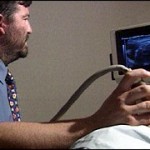BBC News November 12, 1998
A Chinese remedy for breech births which involves burning a herb at the toe of a pregnant woman actually works, clinical tests have shown.
A study by Italian obstetrician and acupuncturist Dr Francesco Cardini found that the remedy, known as moxibustion, was successful in preventing breech births.
A study of 130 women, using ultrasound tests, found that moxibustion worked in 75% of cases, compared with 48% of babies who got no treatment.
It is highlighted in a huge American survey of alternative medicine, published in the Journal of the American Medical Association (JAMA).
Moxibustion involves rolling the herb Artemesia, commonly known as mugwort in the West, into a cigar shape and setting it on fire.
The smoking herb, which smells like marijuana, is then held close to the pregnant woman’s little toe.
Chinese medicine practitioners believe the herb stimulates an acupuncture pressure point in the little toe which leads to foetal movement.
Breech babies are foetuses which have not turned in the womb to ensure they come out head first.
Conventional Western medicine involves kneading the woman’s stomach to stimulate the foetus to move into the correct position.
If this does not work, the woman is given a Caesarian section as breech births are a danger to the baby.
Dr Cardini thinks it is the heat of the herb which causes the baby to move. The technique has no side effects.
One in four
The JAMA has published 80 scientific studies of alternative medicine.
They include another study into a Chinese herbal treatment for irritable bowel syndrome which they also say works.
However, other studies show no scientific evidence to support alternative treatments.
For example, the herb Garcinia cambogia, which is claimed to help people lose weight, was shown not to work.
And a study of acupuncture and nerve pain in HIV sufferers and tests involving chirorpractic spinal manipulation and tension headaches also showed negative results.
Scientists say acupuncture does not relieve nerve pain for people with HIV
The JAMA says an estimated four in 10 Americans – 83m people – now try alternative medicine.
In 1997, they spent around $21.2bn on it and the amount is increasing.
Twenty-five percent more Americans used alternative remedies in 1997 than in 1990.
The most popular treatments include herbal medicine, massage, self help groups and homeopathy.
Confusion
There is some debate about what constitutes alternative medicine, but the JAMA has taken it to mean any treatments for which there is no scientific proof of effectiveness.
Doctors are worried about the lack of regulation in this area and the fact that many patients are using both alternative and traditional medicine.
About 18% of all prescription users also take herbal treatments. According to the JAMA, the number of people who don’t tell their doctors has slightly increased between 1990 and 1997.
There are fears that some traditional drug treatments could react with herbal remedies to cause dangerous side effects.
The US government has increased its investment in research to show whether alternative treatments are clinically effective.
The US Congress set up the Office of Alternative Medicine at the National Institutes of Health six years ago.
It has since changed its name and is now called the National Centre for Complementary and Alternative Medicine. Its budget is set to increase from $20m this year to $50m a year.
In the UK, it is estimated that there are more alternative medicine practitioners than GPs. The industry has been trying to regulate itself in the face of criticism about bogus claims for some treatments.
The European Commission recently issued a report calling for tighter controls on a pan-European basis.

 August 22, 2010 in
August 22, 2010 in 





